ECU SAAB 9-3 2002 Owners Manual
[x] Cancel search | Manufacturer: SAAB, Model Year: 2002, Model line: 9-3, Model: SAAB 9-3 2002Pages: 256, PDF Size: 11.55 MB
Page 1 of 256

1
Owner’s Manual
Saab 9-3 M2002
© Saab Automobile AB 2001 Service Readiness, Saab Automobile AB, Trollhättan, Sweden
Printed in Sweden
Safety 11
Security 35
Convertible 47
Instruments and controls 59
Saab 9-3 Audio System 93
OnStar - Telematics 111
Interior equipment, trunk 123
Starting and driving 145
Car care 185
Maintenance and owner assistance 229
Technical data 233
Index 247
ProCarManuals.com
Page 8 of 256
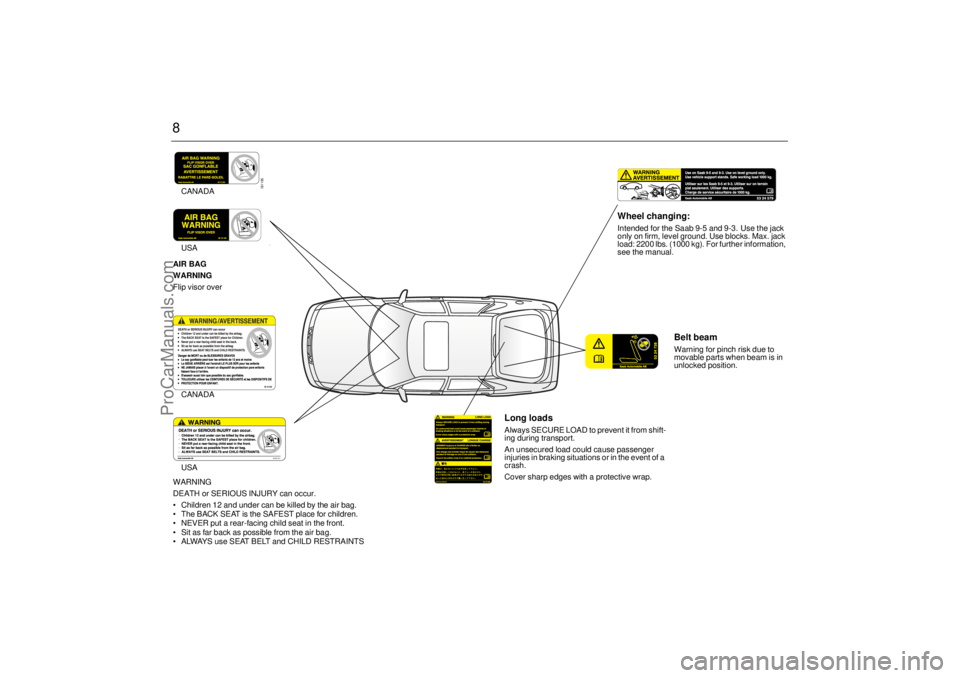
8
Long loads Always SECURE LOAD to prevent it from shift-
ing during transport.
An unsecured load could cause passenger
injuries in braking situations or in the event of a
crash.
Cover sharp edges with a protective wrap.
Belt beam Warning for pinch risk due to
movable parts when beam is in
unlocked position.
Wheel changing: Intended for the Saab 9-5 and 9-3. Use the jack
only on firm, level ground. Use blocks. Max. jack
load: 2200 lbs. (1000 kg). For further information,
see the manual.
AIR BAG
WARNING
Flip visor over
50 10 111
WARNING
DEATH or SERIOUS INJURY can occur.
Children 12 and under can be killed by the air bag.
The BACK SEAT is the SAFEST place for children.
NEVER put a rear-facing child seat in the front.
Sit as far back as possible from the air bag.
ALWAYS use SEAT BELT and CHILD RESTRAINTS
IB1195
USA CANADA
USACANADA
ProCarManuals.com
Page 14 of 256
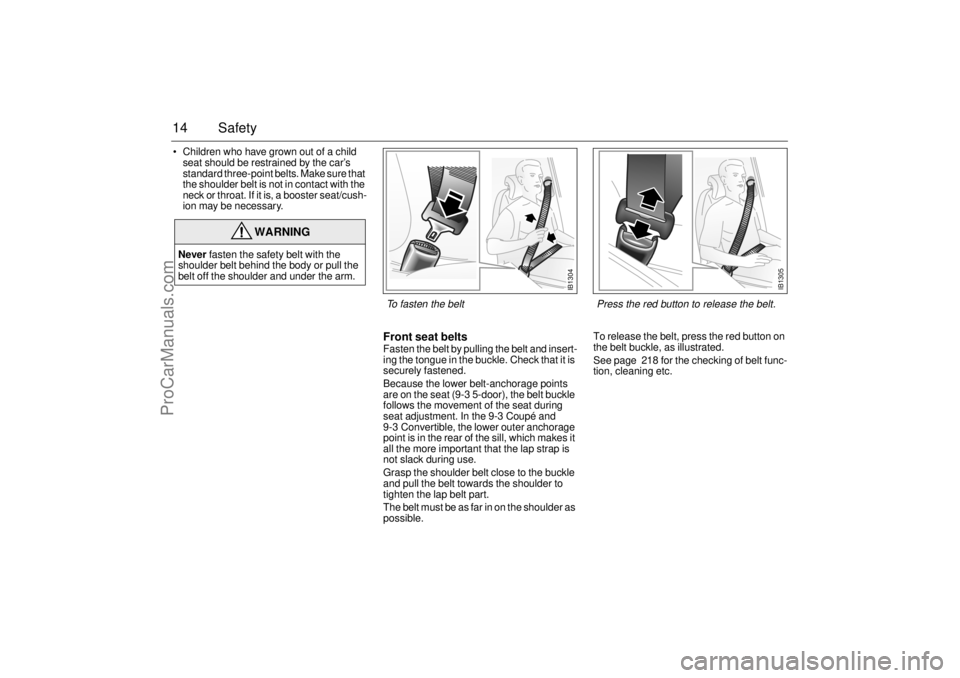
14 Safety Children who have grown out of a child
seat should be restrained by the car’s
standard three-point belts. Make sure that
the shoulder belt is not in contact with the
neck or throat. If it is, a booster seat/cush-
ion may be necessary.
Front seat belts Fasten the belt by pulling the belt and insert-
ing the tongue in the buckle. Check that it is
securely fastened.
Because the lower belt-anchorage points
are on the seat (9-3 5-door), the belt buckle
follows the movement of the seat during
seat adjustment. In the 9-3 Coupé and
9-3 Convertible, the lower outer anchorage
point is in the rear of the sill, which makes it
all the more important that the lap strap is
not slack during use.
Grasp the shoulder belt close to the buckle
and pull the belt towards the shoulder to
tighten the lap belt part.
The belt must be as far in on the shoulder as
possible.To release the belt, press the red button on
the belt buckle, as illustrated.
See page 218 for the checking of belt func-
tion, cleaning etc.
WARNING
Never fasten the safety belt with the
shoulder belt behind the body or pull the
belt off the shoulder and under the arm.
IB1304
To fasten the belt
IB1305
Press the red button to release the belt.
ProCarManuals.com
Page 16 of 256
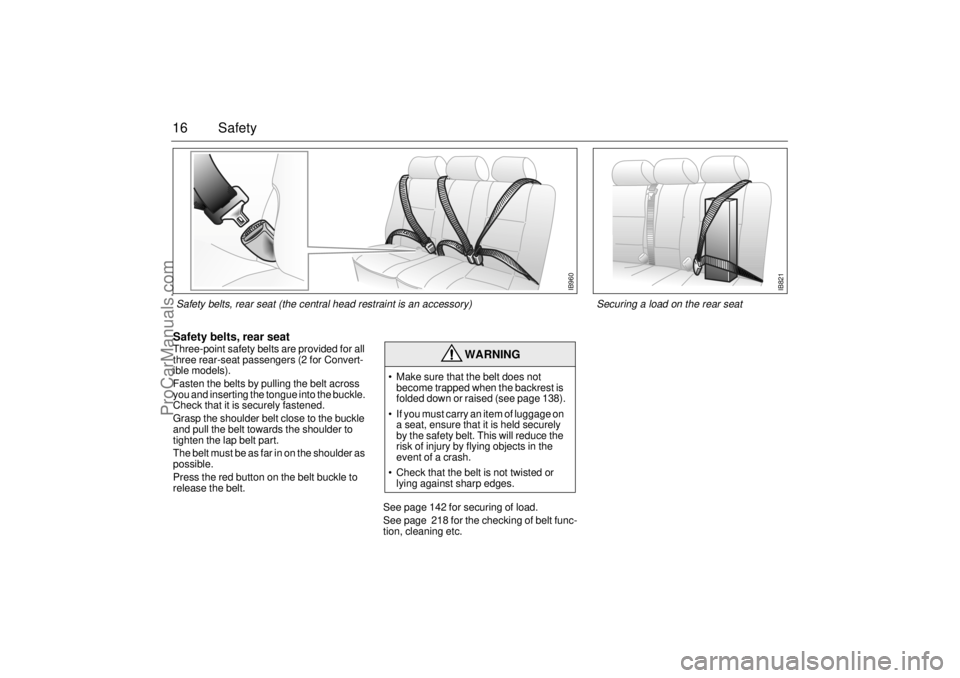
16 SafetySafety belts, rear seat Three-point safety belts are provided for all
three rear-seat passengers (2 for Convert-
ible models).
Fasten the belts by pulling the belt across
you and inserting the tongue into the buckle.
Check that it is securely fastened.
Grasp the shoulder belt close to the buckle
and pull the belt towards the shoulder to
tighten the lap belt part.
The belt must be as far in on the shoulder as
possible.
Press the red button on the belt buckle to
release the belt.
See page 142 for securing of load.
See page 218 for the checking of belt func-
tion, cleaning etc.
WARNING
Make sure that the belt does not
become trapped when the backrest is
folded down or raised (see page 138).
If you must carry an item of luggage on
a seat, ensure that it is held securely
by the safety belt. This will reduce the
risk of injury by flying objects in the
event of a crash.
Check that the belt is not twisted or
lying against sharp edges.
IB960
Safety belts, rear seat (the central head restraint is an accessory)
IB821
Securing a load on the rear seat
ProCarManuals.com
Page 19 of 256
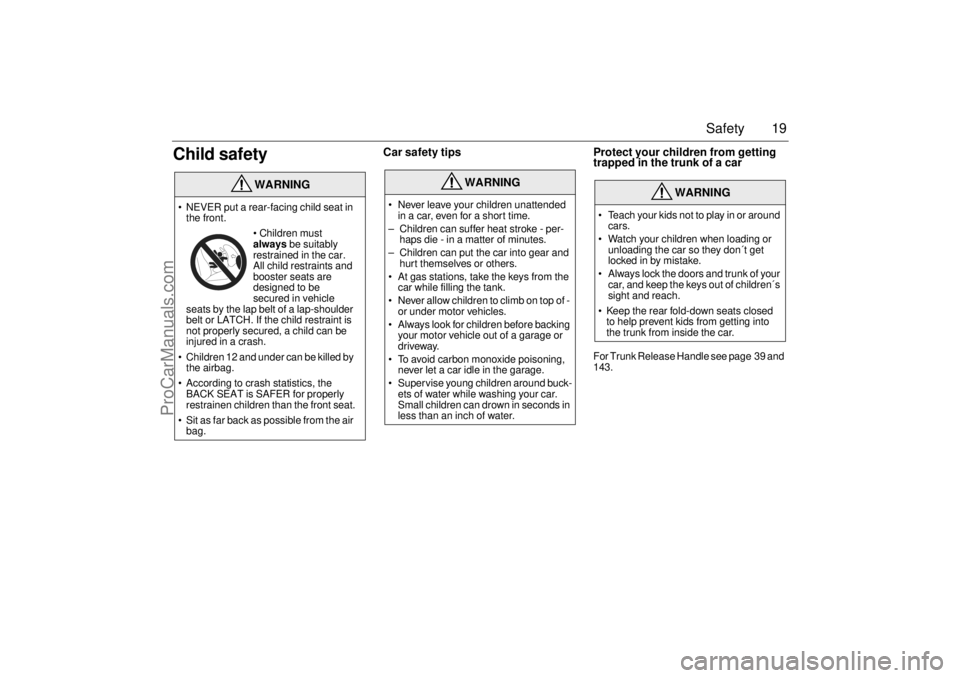
19 Safety
Child safety
Car safety tips Protect your children from getting
trapped in the trunk of a car
For Trunk Release Handle see page 39 and
143.
WARNING
NEVER put a rear-facing child seat in
the front.
Children must
always be suitably
restrained in the car.
All child restraints and
booster seats are
designed to be
secured in vehicle
seats by the lap belt of a lap-shoulder
belt or LATCH. If the child restraint is
not properly secured, a child can be
injured in a crash.
Children 12 and under can be killed by
the airbag.
According to crash statistics, the
BACK SEAT is SAFER for properly
restrainen children than the front seat.
Sit as far back as possible from the air
bag.
WARNING
Never leave your children unattended
in a car, even for a short time.
– Children can suffer heat stroke - per-
haps die - in a matter of minutes.
– Children can put the car into gear and
hurt themselves or others.
At gas stations, take the keys from the
car while filling the tank.
Never allow children to climb on top of -
or under motor vehicles.
Always look for children before backing
your motor vehicle out of a garage or
driveway.
To avoid carbon monoxide poisoning,
never let a car idle in the garage.
Supervise young children around buck-
ets of water while washing your car.
Small children can drown in seconds in
less than an inch of water.
WARNING
Teach your kids not to play in or around
cars.
Watch your children when loading or
unloading the car so they don´t get
locked in by mistake.
Always lock the doors and trunk of your
car, and keep the keys out of children´s
sight and reach.
Keep the rear fold-down seats closed
to help prevent kids from getting into
the trunk from inside the car.
ProCarManuals.com
Page 22 of 256
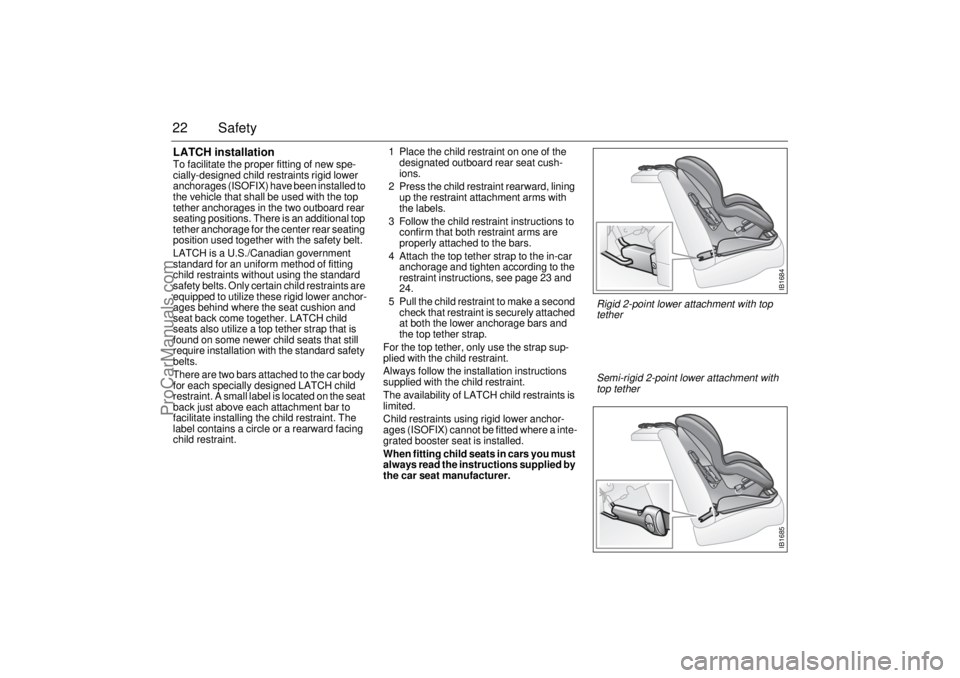
22 SafetyLATCH installationTo facilitate the proper fitting of new spe-
cially-designed child restraints rigid lower
anchorages (ISOFIX) have been installed to
the vehicle that shall be used with the top
tether anchorages in the two outboard rear
seating positions. There is an additional top
tether anchorage for the center rear seating
position used together with the safety belt.
LATCH is a U.S./Canadian government
standard for an uniform method of fitting
child restraints without using the standard
safety belts. Only certain child restraints are
equipped to utilize these rigid lower anchor-
ages behind where the seat cushion and
seat back come together. LATCH child
seats also utilize a top tether strap that is
found on some newer child seats that still
require installation with the standard safety
belts.
There are two bars attached to the car body
for each specially designed LATCH child
restraint. A small label is located on the seat
back just above each attachment bar to
facilitate installing the child restraint. The
label contains a circle or a rearward facing
child restraint. 1 Place the child restraint on one of the
designated outboard rear seat cush-
ions.
2 Press the child restraint rearward, lining
up the restraint attachment arms with
the labels.
3 Follow the child restraint instructions to
confirm that both restraint arms are
properly attached to the bars.
4 Attach the top tether strap to the in-car
anchorage and tighten according to the
restraint instructions, see page 23 and
24.
5 Pull the child restraint to make a second
check that restraint is securely attached
at both the lower anchorage bars and
the top tether strap.
For the top tether, only use the strap sup-
plied with the child restraint.
Always follow the installation instructions
supplied with the child restraint.
The availability of LATCH child restraints is
limited.
Child restraints using rigid lower anchor-
ages (ISOFIX) cannot be fitted where a inte-
grated booster seat is installed.
When fitting child seats in cars you must
always read the instructions supplied by
the car seat manufacturer.
IB1684IB1685
Rigid 2-point lower attachment with top
tether
Semi-rigid 2-point lower attachment with
top tether
ProCarManuals.com
Page 23 of 256
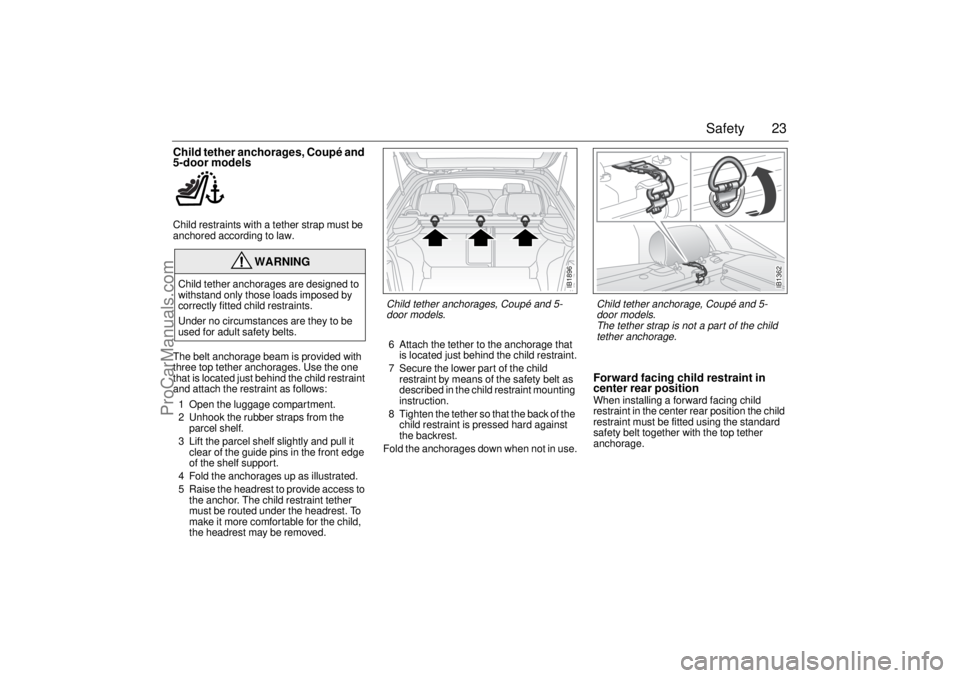
23 Safety
Child tether anchorages, Coupé and
5-door modelsChild restraints with a tether strap must be
anchored according to law.
The belt anchorage beam is provided with
three top tether anchorages. Use the one
that is located just behind the child restraint
and attach the restraint as follows:
1 Open the luggage compartment.
2 Unhook the rubber straps from the
parcel shelf.
3 Lift the parcel shelf slightly and pull it
clear of the guide pins in the front edge
of the shelf support.
4 Fold the anchorages up as illustrated.
5 Raise the headrest to provide access to
the anchor. The child restraint tether
must be routed under the headrest. To
make it more comfortable for the child,
the headrest may be removed.6 Attach the tether to the anchorage that
is located just behind the child restraint.
7 Secure the lower part of the child
restraint by means of the safety belt as
described in the child restraint mounting
instruction.
8 Tighten the tether so that the back of the
child restraint is pressed hard against
the backrest.
Fold the anchorages down when not in use.
Forward facing child restraint in
center rear positionWhen installing a forward facing child
restraint in the center rear position the child
restraint must be fitted using the standard
safety belt together with the top tether
anchorage.
WARNING
Child tether anchorages are designed to
withstand only those loads imposed by
correctly fitted child restraints.
Under no circumstances are they to be
used for adult safety belts.
IB1362
Child tether anchorage, Coupé and 5-
door models.
The tether strap is not a part of the child
tether anchorage.
IB1896
Child tether anchorages, Coupé and 5-
door models.
ProCarManuals.com
Page 24 of 256
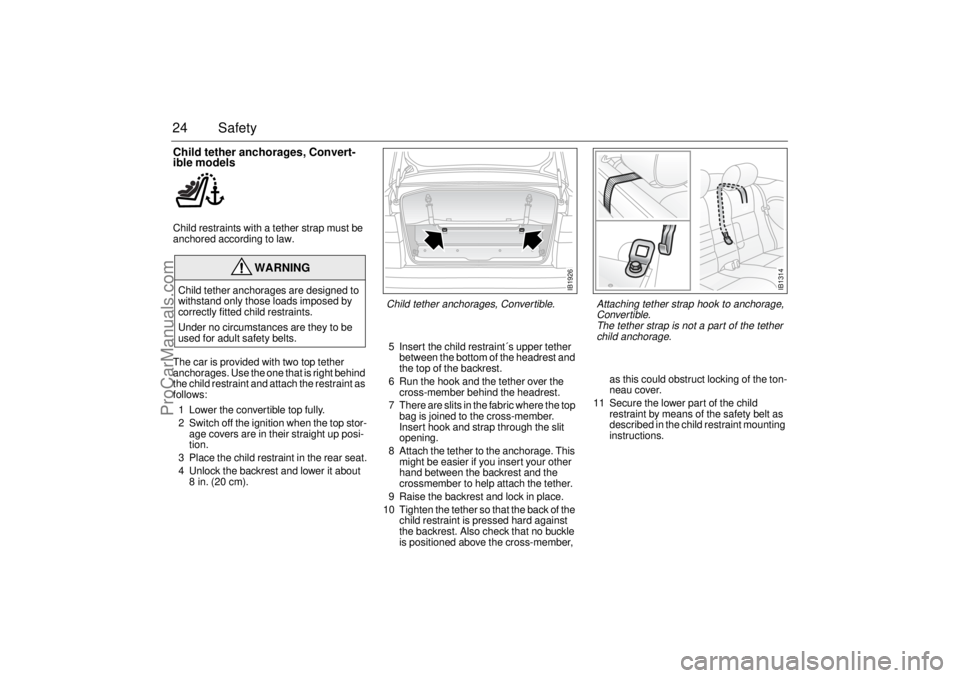
24 SafetyChild tether anchorages, Convert-
ible modelsChild restraints with a tether strap must be
anchored according to law.
The car is provided with two top tether
anchorages. Use the one that is right behind
the child restraint and attach the restraint as
follows:
1 Lower the conver tible top fully.
2 Switch off the ignition when the top stor-
age covers are in their straight up posi-
tion.
3 Place the child restraint in the rear seat.
4 Unlock the backrest and lower it about
8in. (20cm).5 Insert the child restraint´s upper tether
between the bottom of the headrest and
the top of the backrest.
6 Run the hook and the tether over the
cross-member behind the headrest.
7 There are slits in the fabric where the top
bag is joined to the cross-member.
Insert hook and strap through the slit
opening.
8 Attach the tether to the anchorage. This
might be easier if you insert your other
hand between the backrest and the
crossmember to help attach the tether.
9 Raise the backrest and lock in place.
10 Tighten the tether so that the back of the
child restraint is pressed hard against
the backrest. Also check that no buckle
is positioned above the cross-member, as this could obstruct locking of the ton-
neau cover.
11 Secure the lower part of the child
restraint by means of the safety belt as
described in the child restraint mounting
instructions.
WARNING
Child tether anchorages are designed to
withstand only those loads imposed by
correctly fitted child restraints.
Under no circumstances are they to be
used for adult safety belts.
IB1314
Attaching tether strap hook to anchorage,
Conver tible.
The tether strap is not a part of the tether
child anchorage.
IB1926
Child tether anchorages, Convertible.
ProCarManuals.com
Page 25 of 256
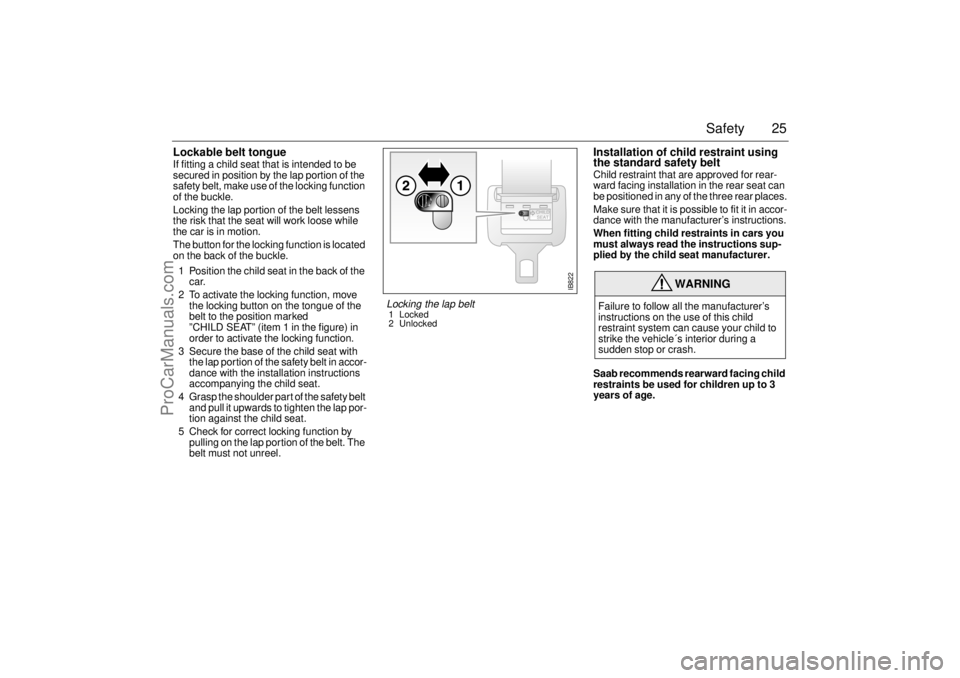
25 Safety
Lockable belt tongue If fitting a child seat that is intended to be
secured in position by the lap portion of the
safety belt, make use of the locking function
of the buckle.
Locking the lap portion of the belt lessens
the risk that the seat will work loose while
the car is in motion.
The button for the locking function is located
on the back of the buckle.
1 Position the child seat in the back of the
car.
2 To activate the locking function, move
the locking button on the tongue of the
belt to the position marked
”CHILD SEAT” (item 1 in the figure) in
order to activate the locking function.
3 Secure the base of the child seat with
the lap portion of the safety belt in accor-
dance with the installation instructions
accompanying the child seat.
4 Grasp the shoulder part of the safety belt
and pull it upwards to tighten the lap por-
tion against the child seat.
5 Check for correct locking function by
pulling on the lap portion of the belt. The
belt must not unreel.
Installation of child restraint using
the standard safety beltChild restraint that are approved for rear-
ward facing installation in the rear seat can
be positioned in any of the three rear places.
Make sure that it is possible to fit it in accor-
dance with the manufacturer’s instructions.
When fitting child restraints in cars you
must always read the instructions sup-
plied by the child seat manufacturer.
Saab recommends rearward facing child
restraints be used for children up to 3
years of age.
WARNING
Failure to follow all the manufacturer’s
instructions on the use of this child
restraint system can cause your child to
strike the vehicle´s interior during a
sudden stop or crash.
IB822
Locking the lap belt 1 Locked
2 Unlocked
ProCarManuals.com
Page 26 of 256
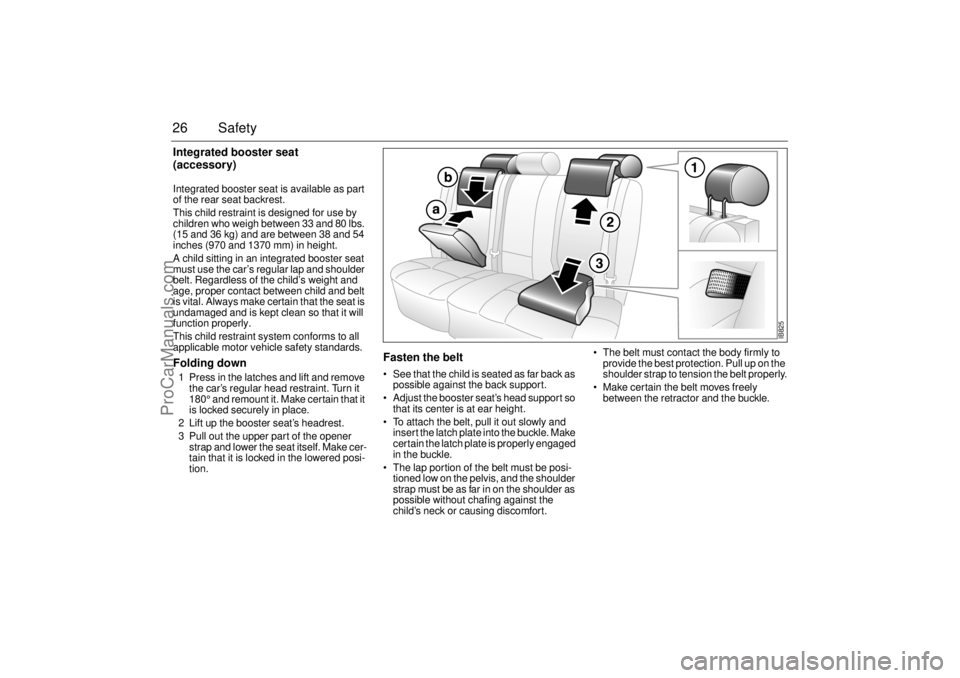
26 SafetyIntegrated booster seat
(accessory)Integrated booster seat is available as part
of the rear seat backrest.
This child restraint is designed for use by
children who weigh between 33 and 80 lbs.
(15 and 36 kg) and are between 38 and 54
inches (970 and 1370 mm) in height.
A child sitting in an integrated booster seat
must use the car’s regular lap and shoulder
belt. Regardless of the child’s weight and
age, proper contact between child and belt
is vital. Always make certain that the seat is
undamaged and is kept clean so that it will
function properly.
This child restraint system conforms to all
applicable motor vehicle safety standards. Folding down1 Press in the latches and lift and remove
the car’s regular head restraint. Turn it
180° and remount it. Make certain that it
is locked securely in place.
2 Lift up the booster seat’s headrest.
3 Pull out the upper part of the opener
strap and lower the seat itself. Make cer-
tain that it is locked in the lowered posi-
tion.
Fasten the belt See that the child is seated as far back as
possible against the back support.
Adjust the booster seat’s head support so
that its center is at ear height.
To attach the belt, pull it out slowly and
insert the latch plate into the buckle. Make
certain the latch plate is properly engaged
in the buckle.
The lap portion of the belt must be posi-
tioned low on the pelvis, and the shoulder
strap must be as far in on the shoulder as
possible without chafing against the
child’s neck or causing discomfort. The belt must contact the body firmly to
provide the best protection. Pull up on the
shoulder strap to tension the belt properly.
Make certain the belt moves freely
between the retractor and the buckle.
IB825
ProCarManuals.com